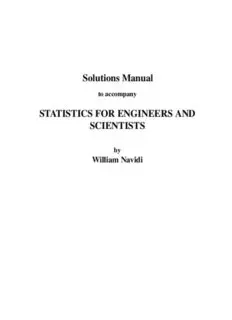Table Of ContentSolutions Manual
to accompany
STATISTICS FOR ENGINEERS AND
SCIENTISTS
by
William Navidi
Table of Contents
Chapter 1 ...............................................................1
Chapter 2 ..............................................................13
Chapter 3 ..............................................................53
Chapter 4 ..............................................................72
Chapter 5 .............................................................115
Chapter 6 .............................................................133
Chapter 7 .............................................................168
Chapter 8 .............................................................190
Chapter 9 .............................................................209
Chapter 10 ............................................................229
SECTION1.1 1
Chapter 1
Section 1.1
1. (a)Thepopulationconsistsofalltheboltsintheshipment. Itistangible.
(b)Thepopulationconsistsofallmeasurementsthatcouldbemadeonthatresistorwiththatohmmeter.
Itisconceptual.
(c)Thepopulationconsistsofallresidentsofthetown.Itistangible.
(d)Thepopulationconsistsofallweldsthatcouldbemadebythatprocess. Itisconceptual.
(e)Thepopulationconsistsofallpartsmanufacturedthatday.Itistangible.
3. (a)False
(b)True
5. (a)No. What is important is the population proportion of defectives; the sample proportion is only an approx-
imation. The population proportion for the new process may in fact be greater or less than that of the old
process.
(b)No. Thepopulationproportionforthenewprocessmaybe0.10ormore,eventhoughthesampleproportion
wasonly0.09.
(c)Finding2defectivebottlesinthesample.
7. Agoodknowledgeoftheprocessthatgeneratedthedata.
2 CHAPTER1
Section 1.2
1. False
3. No. Inthesample1,2,4themeanis7/3,whichdoesnotappearatall.
5. Thesamplesizecanbeanyoddnumber.
7. Yes. Ifallthenumbersinthelistarethesame,thestandarddeviationwillequal0.
9. Themeanandstandarddeviationbothincreaseby5%.
11. The total numberof pointsscored in the class of 30 students is 30 (cid:0) 72 2160. The total number of points
(cid:1)
scoredintheclassof40studentsis40(cid:0) 79 3160.Thetotalnumberofpointsscoredinbothclassescombined
(cid:1)
is2160 3160 5320. Thereare30 40 70studentsinbothclassescombined. Thereforethemeanscore
(cid:2) (cid:1) (cid:2) (cid:1)
forthetwoclassescombinedis5320 70 76.
(cid:3) (cid:1)
13.(a)Allwouldbemultipliedby2.54.
(b)Notexactlythesame,becausethemeasurementswouldbealittledifferentthesecondtime.
15.(a)Thesamplesizeisn 16.Thetertileshavecutpoints 1 3 17 567and 2 3 17 1133.Thefirsttertile
(cid:1) (cid:4) (cid:3) (cid:5)(cid:6)(cid:4) (cid:5)(cid:7)(cid:1) (cid:8) (cid:4) (cid:3) (cid:5)(cid:6)(cid:4) (cid:5)(cid:7)(cid:1) (cid:8)
isthereforetheaverageofthesamplevaluesinpositions5and6,whichis 44 46 2 45.Thesecondtertile
(cid:4) (cid:2) (cid:5)(cid:9)(cid:3) (cid:1)
istheaverageofthesamplevaluesinpositions11and12,whichis 76 79 2 775.
(cid:4) (cid:2) (cid:5)(cid:9)(cid:3) (cid:1) (cid:8)
(b)Thesamplesizeisn 16. Thequintileshavecutpoints i 5 17 fori 1 2 3 4. Thequintilesaretherefore
(cid:1) (cid:4) (cid:3) (cid:5)(cid:6)(cid:4) (cid:5) (cid:1) (cid:10) (cid:10) (cid:10)
the averages of the sample values in positions 3 and 4, in positions 6 and 7, in positions 10 and 11, and in
positions13and14. Thequintilesaretherefore 23 41 2 32, 46 49 2 475, 74 76 2 75,and
(cid:4) (cid:2) (cid:5)(cid:11)(cid:3) (cid:1) (cid:4) (cid:2) (cid:5)(cid:11)(cid:3) (cid:1) (cid:8) (cid:4) (cid:2) (cid:5)(cid:9)(cid:3) (cid:1)
82 89 2 855.
(cid:4) (cid:2) (cid:5)(cid:11)(cid:3) (cid:1) (cid:8)
SECTION1.3 3
Section 1.3
1. (a) Stem Leaf
11 6
12 678
13 13678
14 13368
15 126678899
16 122345556
17 013344467
18 1333558
19 2
20 3
0.16
0.14
cy0.12
n
e
qu 0.1
e
(b)Hereisonehistogram. Otherchoicesfortheendpointsarepossible. e Fr0.08
v
ati0.06
el
R
0.04
0.02
0
11 12 13 14 15 16 17 18 19 20 21
Weight (oz)
(c) 10 12 14 16 18 20 22 24
Weight (ounces)
22
(d)
20
s)
e 18
c
n
u
o Theboxplotshowsnooutliers.
ht ( 16
g
ei 14
W
12
10
4 CHAPTER1
3. Stem Leaf
1 1588
2 00003468
3 0234588
4 0346
5 2235666689
6 00233459
7 113558
8 568
9 1225
10 1
11
12 2
13 06
14
15
16
17 1
18 6
19 9
20
21
22
23 3
Thereare23stemsinthisplot. AnadvantageofthisplotovertheoneinFigure1.6isthatthevaluesaregiven
to thetenths digitinsteadofto theones digit. Adisadvantageis thatthereare toomanystems, andmanyof
themareempty.
5. (a)Herearehistogramsforeachgroup. Otherchoicesfortheendpointsarepossible.
0.25
0.35
0.2 0.3
y y
c c
n n
e e0.25
u u
q0.15 q
e e
Fr Fr 0.2
e e
ativ 0.1 ativ0.15
el el
R R 0.1
0.05
0.05
0 0
18 19 20 21 22 23 24 25 26 15 16 17 18 19 20 21 22 23 24 25
Group 1 measurements (cm) Group 2 measurements (cm)
SECTION1.3 5
30
(b)
m) 25
c
nt (
e
m 20
e
ur
s
a
e
M 15
10
Group 1 Group 2
(c)ThemeasurementsinGroup1aregenerallylargerthanthoseinGroup2.ThemeasurementsinGroup1arenot
farfromsymmetric,althoughtheboxplotsuggestsaslightskewtotheleftsincethemedianisclosertothethird
quartilethanthefirst. Therearenooutliers. MostofthemeasurementsforGroup2arehighlyconcentratedin
anarrowrange,andskewedtotheleftwithinthatrange. Theremainingfourmeasurementsareoutliers.
7. (a)Theproportionisthesumoftherelativefrequencies(heights)oftherectanglesabove130.Thissumisapprox-
imately012 0045 0045 002 0005 0005 024.Thisisclosestto25%.
(cid:8) (cid:2) (cid:8) (cid:2) (cid:8) (cid:2) (cid:8) (cid:2) (cid:8) (cid:2) (cid:8) (cid:1) (cid:8)
(b)The heightofthe rectangleoverthe interval130–135isgreater thanthe sumof theheightsoftherectangles
overtheinterval140–150. Thereforetherearemorewomenintheinterval130–135mm.
18
15
9. (a)
Frequency192
6
3
0
1 3 5 7 9 1113151719212325
Emissions (g/gal)
6 CHAPTER1
0.15
(b)
0.1
Density
0.05
0
1 3 5 7 9 1113151719212325
Emissions (g/gal)
(c)Yes,theshapesofthehistogramsarethesame.
11. Anypointmorethan1.5IQR(interquartilerange)belowthefirstquartileorabovethethirdquartileislabeled
an outlier. To find the IQR, arrange the values in order: 4, 10, 20, 25, 31, 36, 37, 41, 44, 68, 82. There are
n 11values. Thefirstquartileisthevalueinposition025 n 1 3,whichis20. Thethirdquartileisthe
(cid:1) (cid:8) (cid:4) (cid:2) (cid:5) (cid:1)
valueinposition075 n 1 9,whichis44. Theinterquartilerangeis44 20 24. So1.5IQRisequalto
(cid:8) (cid:4) (cid:2) (cid:5) (cid:1) (cid:1) (cid:1)
15 24 36.Therearenopointslessthan20 36 16,sotherearenooutliersonthelowside. Thereis
(cid:4) (cid:8) (cid:5) (cid:4) (cid:5) (cid:1) (cid:1) (cid:1) (cid:1)
onepoint,82,thatisgreaterthan44 36 80. Therefore82istheonlyoutlier.
(cid:2) (cid:1)
13. Thefigureontheleftisasketchofseparatehistogramsforeachgroup. Thehistogramontherightisasketch
ofahistogramforthetwogroupscombined. Thereismorespreadinthecombinedhistogramthanineitherof
theseparateones. Thereforethestandarddeviationofall200heightsisgreaterthan2.5in. Theansweris(ii).
15.(a)IQR=3rdquartile 1stquartile. A:IQR=602 142 460,B:IQR=913 527 386
(cid:1) (cid:8) (cid:1) (cid:8) (cid:1) (cid:8) (cid:8) (cid:1) (cid:8) (cid:1) (cid:8)
SECTION1.3 7
12
10
8
(b)Yes, since the minimum is within 1.5 IQR of the first quartile and the
6
maximum is within 1.5 IQR of the third quartile, there are no outliers,
andthegivennumbersspecifytheboundariesoftheboxandtheendsof 4
thewhiskers. 2
0
(c)No. Theminimumvalueof 2235isan“outlier,”sinceitismorethan1.5timestheinterquartilerangebelow
(cid:1) (cid:8)
thefirstquartile. Thelowerwhiskershouldextendtothesmallestpointthatisnotanoutlier,butthevalueof
thispointisnotgiven.
500
17.(a)
400
a)
P
M
s (300
s
e
Str
ure 200
ct
a
Fr
100
0
(b)Theboxplotindicatesthatthevalue470isanoutlier.
(c) 0 100 200 300 400 500
Fracture Strength (MPa)
(d)Thedotplotindicatesthatthevalue384isdetachedfromthebulkofthedata,andthuscouldbeconsideredto
beanoutlier.
8 CHAPTER1
60
19.(a)
50
40
y 30 Therelationshipisnon-linear.
20
10
0
0 5 10 15
x
x 1.4 2.4 4.0 4.9 5.7 6.3 7.8 9.0 9.3 11.0
(b)
lny 0.83 1.31 1.74 2.29 1.93 2.76 2.73 3.61 3.54 3.97
4
3.5
3
2.5
ln y Therelationshipisapproximatelylinear.
2
1.5
1
0.5
0 5 10 15
x
(c)Itwouldbeeasiertoworkwithxandlny,becausetherelationshipisapproximatelylinear.
Supplementary Exercises for Chapter 1
1. (a)Themeanwillbedividedby2.2.
(b)Thestandarddeviationwillbedividedby2.2.
3. (a)False. The true percentage could be greater than 5%, with the observation of 4 out of 100 due to sampling
variation.

